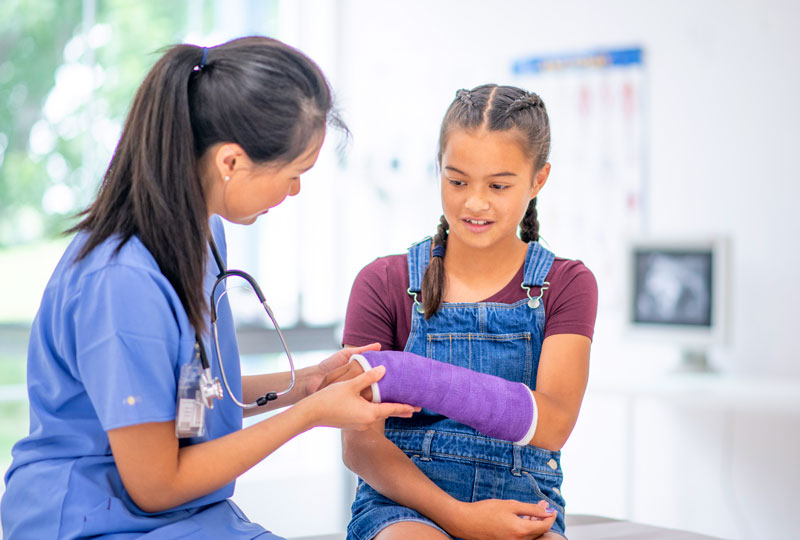From first aid protocols to when to seek out a pediatric orthopaedic surgeon, here’s what you need to know to be prepared for an injury.
Kids will be kids. Climbing trees, jumping off jungle gyms, riding bikes, playing ball, bouncing on the neighbor’s trampoline — all of these come with the territory when you’re young. Unfortunately, these activities can also lead to broken bones.
“Children’s bones are made a little different than adult bones,” said David Ebenezer, M.D., an orthopaedic surgeon at Vanderbilt Children’s Orthopaedics. “They are more flexible but also break under different conditions — therefore it’s pretty easy for a kid to break their arm or leg just from simply tripping and falling the wrong way.”
The good news? Those same bones heal better than their adult counterparts and can usually be healed with a brace or a cast. To better understand children’s bone fractures — and to prepare you and yours for what could be an inevitable injury — we asked Ebenezer to share his insights on recognizing injuries and seeking help for broken bones.
Symptoms of a bone fracture
Ebenezer says there are four things to keep in mind when attempting to gauge whether a bone is broken:
- Fractures usually happen after an injury. “Unless there is some other underlying medical issue,” Ebenezer said, “fractures don’t usually happen with everyday low-risk non-contact activities.”
- Fractures almost always hurt. Children can sometimes have what is called an occult fracture, Ebenezer explained, where it isn’t obvious on Xray initially — but they’ll have specific pain after an injury.
- Fractures usually swell. “Bones are alive, and being alive the means they have great blood flow,” he said. “When a bone breaks, it bleeds, and this creates swelling.”
- Fractures make it painful to move a joint or to bear weight, even if they don’t hurt at rest. “So refusal to move an elbow or refusal to bear weight on a leg after an injury can suggest a fracture,” he said.
Types of bone fractures
There are all sorts of different bone fracture types and locations, Ebenezer said, mentioning that the most common differentiation in kids is a buckle fracture versus a complete fracture.
- In a buckle or “torus” fracture, the bone has been injured “sort of like a crumple zone in a car, where the overall structure is intact and stable but part of the bone has been compressed,” Ebenezer said. This doesn’t result in any deformity but has all the other symptoms of a break.
- In a complete fracture, the bone is essentially broken all the way through. This can be non-displaced, where all the pieces are where they are supposed to be, or displaced, meaning the bones have some degree of deformity. “The big question in this case is whether or not the fracture is displaced enough to require a procedure to bring it back into an acceptable position,” Ebenezer said. “This is really the big decision point in fracture care and should really be made by an expert who takes care of enough children’s bone fracture to make a good judgment.”
First aid after a bone fracture
“Immoblization is the first thing to address,” Ebenezer said. “Getting the fracture immobilized will prevent it from displacing and causing pain, as broken bones hurt quite a bit, especially when they get moved around a lot. This can be done with a splint, or there are some Velcro braces than can be used. Second is pain control. Third is ice and elevation to help with swelling.”
When to consult a doctor
If you have access to a fracture clinic, you’ll see a fellowship-trained pediatric orthopaedic surgeon with advanced training in management of all fractures. Think of it as a single stop for evaluation and comprehensive management of the injury.
Anytime you have a suspicion for a fracture, a doctor should be consulted. This can start with your pediatrician or a doctor at the emergency department for initial first aid and diagnosis, but ultimately it is best to see a pediatric orthopaedic surgeon at a specialty clinic or hospital for management.
As for timing, that depends on severity, said Ebenezer: “If the injury is obvious — deformity, swelling, etc. — and is of a large weight-bearing bone, then emergency care at an urgent care or ED with access to a surgeon is preferable in case urgent surgery is necessary. If the injury is immobilized and manageable, you should still see a pediatric orthopaedic surgeon to determine which treatment is going to be optimal for the injury, but this can potentially be in-clinic within a couple of days.”
If you have access to a fracture clinic, you’ll see a fellowship-trained pediatric orthopaedic surgeon with advanced training in management of all fractures, who can evaluate the injury and determine definitive care, whether that is non-operative or operative. Think of it as a single stop for evaluation and comprehensive management of the injury.
Treatment for bone fractures
A buckle fracture or a non-displaced but stable fracture pattern is typically treated in either a cast or a brace, usually for 4-6 weeks. “If the fracture is angulated,” Ebenezer said, “sometimes this requires what we call a closed reduction, commonly known as “setting” the bone. If the fracture is displaced or angulated enough, and cannot be predictably reduced, it can require surgery.”
Parents can expect to return for follow-up one week after casting to make sure alignment has been maintained. After the cast comes off, Xrays will be repeated to see if there is enough healing to begin range-of-motion exercises. Since additional healing is needed, the final follow-up will be at 10-12 weeks post injury to ensure release to activities.
Why you may need a pediatric orthopaedic surgeon
Due to the fact that growth plates are made of cartilage and are a little weaker than the bone, a child’s bone fracture frequently goes through the growth plate. “This can require different treatment and longer follow-up to make sure the growth plate is still growing normally after an injury,” Ebenezer said. “In addition, because children heal and remodel bones so well, fractures don’t necessarily have to look ‘perfect’ to heal perfectly — however, there are specifics on what is and isn’t acceptable with regards to residual deformity in fractures. This requires judgment that a pediatric orthopaedic surgeon is best equipped to handle.”

Vanderbilt Children’s Fracture Clinic in Murfreesboro is here to treat children’s bone fracture injuries quickly and conveniently.

